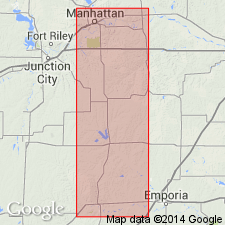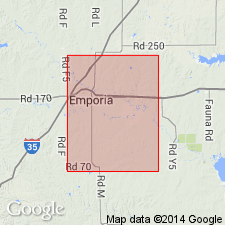
- Usage in publication:
-
- Alma limestone
- Modifications:
-
- Original reference
- Dominant lithology:
-
- Limestone
- AAPG geologic province:
-
- Forest City basin
Summary:
Pg. 44-45. Alma limestone. Light-yellowish-gray massive limestone, 5.5 feet thick, quarried at Alma and locally known as "Alma stone." Same as Cottonwood or Manhattan limestone. [Age is Permian.]
[Named from Alma, Wabaunsee Co., northeastern KS.]
Source: US geologic names lexicon (USGS Bull. 896, p. 36).

- Usage in publication:
-
- Alma limestone†
- Modifications:
-
- Abandoned
- AAPG geologic province:
-
- Forest City basin
Summary:
†Alma limestone of Council Grove group replaced with Cottonwood limestone. In a note at the conclusion of this article, the author states that he "withdraws the name Alma limestone and retains Cottonwood limestone as the name of the Kansas formation" in compliance with the decision of the U.S. Geological Survey Committee on Formation Names dated October 29, 1902.
Source: US geologic names lexicon (USGS Bull. 896, p. 36); supplemental information from GNU records (USGS DDS-6; Denver GNULEX).
For more information, please contact Nancy Stamm, Geologic Names Committee Secretary.
Asterisk (*) indicates published by U.S. Geological Survey authors.
"No current usage" (†) implies that a name has been abandoned or has fallen into disuse. Former usage and, if known, replacement name given in parentheses ( ).
Slash (/) indicates name conflicts with nomenclatural guidelines (CSN, 1933; ACSN, 1961, 1970; NACSN, 1983, 2005, 2021). May be explained within brackets ([ ]).

